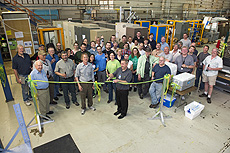Fermilab revives long-retired beamline
 |
Staff celebrate the Fermilab Test Beam Facility's newly refurbished, second beamline. Fermilab Director Nigel Lockyer joins the team responsible for bringing the beam online with a toast and root beer. Photo: Reidar Hahn |
For eight years, Fermilab's MCenter beamline lay dormant, having been retired when the Main Injector Particle Production experiment turned off in 2006.
This week Fermilab celebrated its resurrection. At a ribbon cutting ceremony at the Fermilab Test Beam Facility on Monday, Fermilab Director Nigel Lockyer recognized many people's dedication in bringing the beamline back to life. PPD's Erik Ramberg, head of detector R&D, led the multiyear effort.
"Adding an additional beamline as part of the Test Beam Facility, which has been a raging success, has taken many years," Ramberg told the crowd. "All of you have been a part of this."
The beamline will provide laboratory users with a second test beam at the Fermilab Test Beam Facility. With users' demand for beam time at the facility ever increasing, the new beam couldn't come soon enough.
"It was better to keep the beamline alive than let it fall into irrevocable disrepair," Ramberg said. "It was dusty and woebegone; this thing was lying fallow. We were missing an opportunity to bring another beamline into operation."
So in 2009, Ramberg approached DOE about reviving it. Test beams, he said, are essential for detector research. Without them, it's impossible to know how a detector responds to particles coming out of an accelerator. Adding the beamline — which was already built and only needed refurbishing — would open more avenues for exploring detector technologies.
DOE gave Ramberg the green light, and he and members of the Accelerator Division, Computing Sector and the Particle Physics Division went to work. PPD's Walt Jaskierny and Jim Kilmer revived the power supplies and installed needed magnets in the user area. Michael Backfish and Tom Kobilarcik led the beamline commissioning.
"Because the beamline was off for that time, nobody knew what states the magnets and power supplies were in," said Aria Soha, Fermilab test beam coordinator.
Late last month, the beamline was finally up and running.
Researchers on the LArIAT experiment have already reserved time in the MC7 beam to characterize their liquid-argon detector.
At Monday's celebration, Lockyer did the honor of cutting a ribbon that cordoned the new MCenter Control Room and beamline, located adjacent to the busy MTest Control Room.
"The existing test beam brings in many people from many countries, and now we have a second beamline," Lockyer said. "It's a good time to celebrate."
—Leah Hesla
|